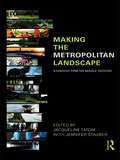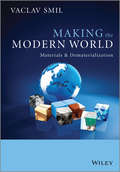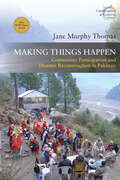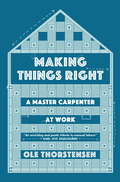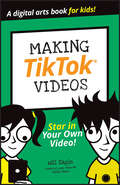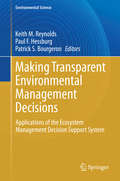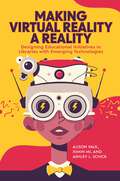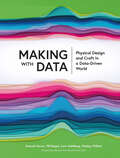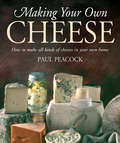- Table View
- List View
Making the Metropolitan Landscape: Standing Firm on Middle Ground
by Jacqueline Tatom Jennifer StauberThe American landscape is an extremely complex terrain born from a history of collective and individual experiences. These created environments, which all may be called metropolitan landscapes, constantly challenge students and professionals in the fields of architecture, design and planning to consider new ways of making lively public places. This book brings together varied voices in urban design theory and practice to explore new ways of understanding place and our position in it.
Making the Modern World: Materials and Dematerialization
by Vaclav SmilHow much further should the affluent world push its material consumption? Does relative dematerialization lead to absolute decline in demand for materials? These and many other questions are discussed and answered in Making the Modern World: Materials and Dematerialization. Over the course of time, the modern world has become dependent on unprecedented flows of materials. Now even the most efficient production processes and the highest practical rates of recycling may not be enough to result in dematerialization rates that would be high enough to negate the rising demand for materials generated by continuing population growth and rising standards of living. This book explores the costs of this dependence and the potential for substantial dematerialization of modern economies. Making the Modern World: Materials and Dematerialization considers the principal materials used throughout history, from wood and stone, through to metals, alloys, plastics and silicon, describing their extraction and production as well as their dominant applications. The evolving productivities of material extraction, processing, synthesis, finishing and distribution, and the energy costs and environmental impact of rising material consumption are examined in detail. The book concludes with an outlook for the future, discussing the prospects for dematerialization and potential constrains on materials. This interdisciplinary text provides useful perspectives for readers with backgrounds including resource economics, environmental studies, energy analysis, mineral geology, industrial organization, manufacturing and material science.
Making the Modern World: Materials and Dematerialization
by Vaclav SmilHow much further should the affluent world push its material consumption? Does relative dematerialization lead to absolute decline in demand for materials? These and many other questions are discussed and answered in Making the Modern World: Materials and Dematerialization. Over the course of time, the modern world has become dependent on unprecedented flows of materials. Now even the most efficient production processes and the highest practical rates of recycling may not be enough to result in dematerialization rates that would be high enough to negate the rising demand for materials generated by continuing population growth and rising standards of living. This book explores the costs of this dependence and the potential for substantial dematerialization of modern economies. Making the Modern World: Materials and Dematerialization considers the principal materials used throughout history, from wood and stone, through to metals, alloys, plastics and silicon, describing their extraction and production as well as their dominant applications. The evolving productivities of material extraction, processing, synthesis, finishing and distribution, and the energy costs and environmental impact of rising material consumption are examined in detail. The book concludes with an outlook for the future, discussing the prospects for dematerialization and potential constrains on materials. This interdisciplinary text provides useful perspectives for readers with backgrounds including resource economics, environmental studies, energy analysis, mineral geology, industrial organization, manufacturing and material science.
Making Things Happen: Community Participation and Disaster Reconstruction in Pakistan (Catastrophes in Context #5)
by Jane Murphy ThomasDrawing on the Pakistan Earthquake Reconstruction and Recovery Project (PERRP), this volume explores the sociocultural side of post-disaster infrastructure reconstruction. As the latter is often fraught with delays and even abandonment—one cause being ineffective interactions between construction and local people—PERRP used anthropological and participatory approaches. Along with strong construction management, such approaches led to the rebuilding being completed on time. As disasters are increasing in number and intensity, so too will be the need for reconstruction, for which PERRP has lessons to offer.
Making Things Happen: Community Participation and Disaster Reconstruction in Pakistan (Catastrophes in Context #5)
by Jane Murphy ThomasDrawing on the Pakistan Earthquake Reconstruction and Recovery Project (PERRP), this volume explores the sociocultural side of post-disaster infrastructure reconstruction. As the latter is often fraught with delays and even abandonment—one cause being ineffective interactions between construction and local people—PERRP used anthropological and participatory approaches. Along with strong construction management, such approaches led to the rebuilding being completed on time. As disasters are increasing in number and intensity, so too will be the need for reconstruction, for which PERRP has lessons to offer.
Making Things Right: A Master Carpenter at Work
by Ole ThorstensenA celebration of good craftsmanship by a Norwegian master carpenter - the anatomy of a job well done."An enriching and poetic tribute to manual labour" Karl Ove Knausgård"In Thorstensen's skilled hands, the everyday story of a suburban loft conversion is turned into an urgent study on the value of doing good work. It should be widely read." Robert Penn - author of The Man Who Made Things Out of TreesThis is, quite simply, the story of a loft conversion. It is also a book about work and identity, about collaboration and pride in skilled craftsmanship, and about what it means to make things with your hands in a consumerism-driven world. A master carpenter and builder with thirty years' experience, Thorstensen gives a matter-of-fact, reflective voice to the workers who construct our living spaces and our urban environment. He looks upon his tools as an important part of himself and as a reflection of his respect for his trade, and he addresses the gulf in understanding and communication between skilled craftsmen and "academic" workers. From the moment of a client's phone call to their occupation of a newly constructed living space, Making Things Right tracks the project as it takes shape: the delicate negotiation to establish an optimum plan; the collaboration with a trusted team of specialist painters, plasterers, plumbers, electricians; the handling of materials; the blood, sweat and frustration involved in doing a job well. Why is it that manual skills are underestimated? After all, working with your hands gives you time to think. With all its practical detail, Making Things Right is the simple philosophy of a working life.Will interest readers of The Craftsman by Richard Sennett: Kitchen Confidential by Anthony Bourdain; The Man Who Made Things Out of Trees by Robert Penn; Do No Harm by James Marsh and A Shepherd's Life by James RebanksTranslated from the Norwegian by Sean Kinsella
Making TikTok Videos (Dummies Junior)
by Will Eagle Hannah Budke Claire Cohen Andrew Cooper Jordan Elijah Michael Andrew PanturescuCreate videos using the tricks of TikTok stars! Making TikTok Videos reveals the secrets that TikTok celebs and influencers use to make the videos that everyone’s watching. Hilarious clips, the latest dances, instruction videos—whatever you want to do, make sure it shows off the latest TikTok styles. This book shows you how to use whatever you have on hand to record, edit, and upload TikToks. Add music and text, get creative, and start sharing your finished products. With this guide, you’ll get easy instructions on how to make videos that people remember. You also get some tips on how to bring viewers to your account. Use your mobile device to shoot videos with top-notch sound Learn the editing tricks TikTok pros use to create a finished video Set up your TikTok account and set your privacy Keep up with the latest TikTok video stylesWritten especially for the 10-14 age group interested in creating their first TikTok videos, this Dummies Jr. title will help you get plugged into the TikTok universe.
Making TikTok Videos (Dummies Junior)
by Will Eagle Hannah Budke Claire Cohen Andrew Cooper Jordan Elijah Michael Andrew PanturescuCreate videos using the tricks of TikTok stars! Making TikTok Videos reveals the secrets that TikTok celebs and influencers use to make the videos that everyone’s watching. Hilarious clips, the latest dances, instruction videos—whatever you want to do, make sure it shows off the latest TikTok styles. This book shows you how to use whatever you have on hand to record, edit, and upload TikToks. Add music and text, get creative, and start sharing your finished products. With this guide, you’ll get easy instructions on how to make videos that people remember. You also get some tips on how to bring viewers to your account. Use your mobile device to shoot videos with top-notch sound Learn the editing tricks TikTok pros use to create a finished video Set up your TikTok account and set your privacy Keep up with the latest TikTok video stylesWritten especially for the 10-14 age group interested in creating their first TikTok videos, this Dummies Jr. title will help you get plugged into the TikTok universe.
Making Time: Astronomical Time Measurement in Tokugawa Japan (Studies of the Weatherhead East Asian Institute)
by Yulia FrumerWhat is time made of? We might balk at such a question, and reply that time is not made of anything—it is an abstract and universal phenomenon. In Making Time, Yulia Frumer upends this assumption, using changes in the conceptualization of time in Japan to show that humans perceive time as constructed and concrete. In the mid-sixteenth century, when the first mechanical clocks arrived in Japan from Europe, the Japanese found them interesting but useless, because they failed to display time in units that changed their length with the seasons, as was customary in Japan at the time. In 1873, however, the Japanese government adopted the Western equal-hour system as well as Western clocks. Given that Japan carried out this reform during a period of rapid industrial development, it would be easy to assume that time consciousness is inherent to the equal-hour system and a modern lifestyle, but Making Time suggests that punctuality and time-consciousness are equally possible in a society regulated by a variable-hour system, arguing that this reform occurred because the equal-hour system better reflected a new conception of time — as abstract and universal—which had been developed in Japan by a narrow circle of astronomers, who began seeing time differently as a result of their measurement and calculation practices. Over the course of a few short decades this new way of conceptualizing time spread, gradually becoming the only recognized way of treating time.
Making Time: Astronomical Time Measurement in Tokugawa Japan (Studies of the Weatherhead East Asian Institute)
by Yulia FrumerWhat is time made of? We might balk at such a question, and reply that time is not made of anything—it is an abstract and universal phenomenon. In Making Time, Yulia Frumer upends this assumption, using changes in the conceptualization of time in Japan to show that humans perceive time as constructed and concrete. In the mid-sixteenth century, when the first mechanical clocks arrived in Japan from Europe, the Japanese found them interesting but useless, because they failed to display time in units that changed their length with the seasons, as was customary in Japan at the time. In 1873, however, the Japanese government adopted the Western equal-hour system as well as Western clocks. Given that Japan carried out this reform during a period of rapid industrial development, it would be easy to assume that time consciousness is inherent to the equal-hour system and a modern lifestyle, but Making Time suggests that punctuality and time-consciousness are equally possible in a society regulated by a variable-hour system, arguing that this reform occurred because the equal-hour system better reflected a new conception of time — as abstract and universal—which had been developed in Japan by a narrow circle of astronomers, who began seeing time differently as a result of their measurement and calculation practices. Over the course of a few short decades this new way of conceptualizing time spread, gradually becoming the only recognized way of treating time.
Making Time: Astronomical Time Measurement in Tokugawa Japan (Studies of the Weatherhead East Asian Institute)
by Yulia FrumerWhat is time made of? We might balk at such a question, and reply that time is not made of anything—it is an abstract and universal phenomenon. In Making Time, Yulia Frumer upends this assumption, using changes in the conceptualization of time in Japan to show that humans perceive time as constructed and concrete. In the mid-sixteenth century, when the first mechanical clocks arrived in Japan from Europe, the Japanese found them interesting but useless, because they failed to display time in units that changed their length with the seasons, as was customary in Japan at the time. In 1873, however, the Japanese government adopted the Western equal-hour system as well as Western clocks. Given that Japan carried out this reform during a period of rapid industrial development, it would be easy to assume that time consciousness is inherent to the equal-hour system and a modern lifestyle, but Making Time suggests that punctuality and time-consciousness are equally possible in a society regulated by a variable-hour system, arguing that this reform occurred because the equal-hour system better reflected a new conception of time — as abstract and universal—which had been developed in Japan by a narrow circle of astronomers, who began seeing time differently as a result of their measurement and calculation practices. Over the course of a few short decades this new way of conceptualizing time spread, gradually becoming the only recognized way of treating time.
Making Time: Astronomical Time Measurement in Tokugawa Japan (Studies of the Weatherhead East Asian Institute)
by Yulia FrumerWhat is time made of? We might balk at such a question, and reply that time is not made of anything—it is an abstract and universal phenomenon. In Making Time, Yulia Frumer upends this assumption, using changes in the conceptualization of time in Japan to show that humans perceive time as constructed and concrete. In the mid-sixteenth century, when the first mechanical clocks arrived in Japan from Europe, the Japanese found them interesting but useless, because they failed to display time in units that changed their length with the seasons, as was customary in Japan at the time. In 1873, however, the Japanese government adopted the Western equal-hour system as well as Western clocks. Given that Japan carried out this reform during a period of rapid industrial development, it would be easy to assume that time consciousness is inherent to the equal-hour system and a modern lifestyle, but Making Time suggests that punctuality and time-consciousness are equally possible in a society regulated by a variable-hour system, arguing that this reform occurred because the equal-hour system better reflected a new conception of time — as abstract and universal—which had been developed in Japan by a narrow circle of astronomers, who began seeing time differently as a result of their measurement and calculation practices. Over the course of a few short decades this new way of conceptualizing time spread, gradually becoming the only recognized way of treating time.
Making Tobacco Bright: Creating an American Commodity, 1617–1937 (Johns Hopkins Studies in the History of Technology)
by Barbara M. HahnIn her sweeping history of the American tobacco industry, Barbara Hahn traces the emergence of the tobacco plant’s many varietal types, arguing that they are products not of nature but of economic relations and continued and intense market regulation. Hahn focuses her study on the most popular of these varieties, Bright Flue-Cured Tobacco. First grown in the inland Piedmont along the Virginia–North Carolina border, Bright Tobacco now grows all over the world, primarily because of its unique—and easily replicated—cultivation and curing methods. Hahn traces the evolution of technologies in a variety of regulatory and cultural environments to reconstruct how Bright Tobacco became, and remains to this day, a leading commodity in the global tobacco industry. This study asks not what effect tobacco had on the world market, but how that market shaped tobacco into types that served specific purposes and became distinguishable from one another more by technologies of production than genetics. In so doing, it explores the intersection of crossbreeding, tobacco-raising technology, changing popular demand, attempts at regulation, and sheer marketing ingenuity during the heyday of the American tobacco industry. Combining economic theory with the history of technology, Making Tobacco Bright revises several narratives in American history, from colonial staple-crop agriculture to the origins of the tobacco industry to the rise of identity politics in the twentieth century.
Making Tobacco Bright: Creating an American Commodity, 1617–1937 (Johns Hopkins Studies in the History of Technology)
by Barbara M. HahnIn her sweeping history of the American tobacco industry, Barbara Hahn traces the emergence of the tobacco plant’s many varietal types, arguing that they are products not of nature but of economic relations and continued and intense market regulation. Hahn focuses her study on the most popular of these varieties, Bright Flue-Cured Tobacco. First grown in the inland Piedmont along the Virginia–North Carolina border, Bright Tobacco now grows all over the world, primarily because of its unique—and easily replicated—cultivation and curing methods. Hahn traces the evolution of technologies in a variety of regulatory and cultural environments to reconstruct how Bright Tobacco became, and remains to this day, a leading commodity in the global tobacco industry. This study asks not what effect tobacco had on the world market, but how that market shaped tobacco into types that served specific purposes and became distinguishable from one another more by technologies of production than genetics. In so doing, it explores the intersection of crossbreeding, tobacco-raising technology, changing popular demand, attempts at regulation, and sheer marketing ingenuity during the heyday of the American tobacco industry. Combining economic theory with the history of technology, Making Tobacco Bright revises several narratives in American history, from colonial staple-crop agriculture to the origins of the tobacco industry to the rise of identity politics in the twentieth century.
Making Transparent Environmental Management Decisions: Applications of the Ecosystem Management Decision Support System (Environmental Science and Engineering)
by Keith M. Reynolds Paul F. Hessburg Patrick S. BourgeronSince 1997, the Ecosystem Management Decision Support (EMDS) system has been used around the world to support environmental analysis and planning in many different application areas, and it has been applied over a wide range of geographic scales, from forest stands to entire countries. An extensive sampling of this diversity of applications is presented in section 2, in which EMDS application developers describe the varied uses of the system. These accounts, together with the requisite background in section 1, provide valuable practical insights into how the system can be applied in the general domain of environmental management.
Making Virtual Reality a Reality: Designing Educational Initiatives in Libraries with Emerging Technologies
by Alison Valk Ximin Mi Ashley L. SchickWalks readers through the key components of developing library-led research and programming that leverages emerging technologies with the goal of engaging students and faculty.As educational curricula and research evolve to include advanced technologies, libraries must offer programming with these emerging technologies in mind, including the use of virtual reality (VR) and augmented reality (AR). In this timely guide, Valk, Mi, and Schick present readers with tools for assessing their level of organizational readiness to begin such programs and, more importantly, how to sustain them with limited budgets, expertise, and resources.Building on their own experiences, the authors teach readers how to develop technology-rich classes, assess student projects, and overcome technical hurdles. They spotlight this kind of programming as integral to building strategic partnerships in an educational environment. Readers will learn how to adapt and design programs or initiatives in which the necessary technologies are rapidly changing, not only in higher education institutions, but also in schools. Worksheets and resources assist readers in reflecting on their own work and developing educational programming to suit their organizational needs.
Making Virtual Reality a Reality: Designing Educational Initiatives in Libraries with Emerging Technologies
by Alison Valk Ximin Mi Ashley L. SchickWalks readers through the key components of developing library-led research and programming that leverages emerging technologies with the goal of engaging students and faculty.As educational curricula and research evolve to include advanced technologies, libraries must offer programming with these emerging technologies in mind, including the use of virtual reality (VR) and augmented reality (AR). In this timely guide, Valk, Mi, and Schick present readers with tools for assessing their level of organizational readiness to begin such programs and, more importantly, how to sustain them with limited budgets, expertise, and resources.Building on their own experiences, the authors teach readers how to develop technology-rich classes, assess student projects, and overcome technical hurdles. They spotlight this kind of programming as integral to building strategic partnerships in an educational environment. Readers will learn how to adapt and design programs or initiatives in which the necessary technologies are rapidly changing, not only in higher education institutions, but also in schools. Worksheets and resources assist readers in reflecting on their own work and developing educational programming to suit their organizational needs.
Making Water Security: A Morphological Account of Nile River Development (IHE Delft PhD Thesis Series)
by Hermen SmitThis book examines Nile water security through the morphology of the river: it uses the always changing form of the river as a theoretical and empirical device to map and understand how infrastructures and discourses dynamically interact with the Nile. By bringing a history of two centuries of dam development on the Nile in relation with the drainage of a hill slope in Ethiopia on the one hand and irrigation reform in Sudan on the other, the author shows how the scales, units and ‘populations’ figuring in projects to securitize the river emerge through the rearrangement of its water and sediments. The analysis of ‘Making water security’ is more than yet another story of how modern projects of water security have legitimized often violent dispossessions of Nile land and water. It shows how no water user is confined by the roles assigned by project engineers and planners. As ongoing modern ‘development’ of the river reduces the prospects for new large diversions of water, the targeted subjects of development and modernization make use of newly opened spaces to carve out their own projects. They creatively mobilize old irrigation and drainage infrastructures in ways that escape the universal logic of water security.
Making Water Security: A Morphological Account of Nile River Development (IHE Delft PhD Thesis Series)
by Hermen SmitThis book examines Nile water security through the morphology of the river: it uses the always changing form of the river as a theoretical and empirical device to map and understand how infrastructures and discourses dynamically interact with the Nile. By bringing a history of two centuries of dam development on the Nile in relation with the drainage of a hill slope in Ethiopia on the one hand and irrigation reform in Sudan on the other, the author shows how the scales, units and ‘populations’ figuring in projects to securitize the river emerge through the rearrangement of its water and sediments. The analysis of ‘Making water security’ is more than yet another story of how modern projects of water security have legitimized often violent dispossessions of Nile land and water. It shows how no water user is confined by the roles assigned by project engineers and planners. As ongoing modern ‘development’ of the river reduces the prospects for new large diversions of water, the targeted subjects of development and modernization make use of newly opened spaces to carve out their own projects. They creatively mobilize old irrigation and drainage infrastructures in ways that escape the universal logic of water security.
Making with Data: Physical Design and Craft in a Data-Driven World (AK Peters Visualization Series)
by Samuel Huron Till Nagel Lora Oehlberg Wesley WillettHow can we give data physical form? And how might those creations change the ways we experience data and the stories it can tell? Making with Data: Physical Design and Craft in a Data-Driven World provides a snapshot of the diverse practices contemporary creators are using to produce objects, spaces, and experiences imbued with data. Across 25+ beautifully-illustrated chapters, international artists, designers, and scientists each explain the process of creating a specific data-driven piece—illustrating their practice with candid sketches, photos, and design artifacts from their own studios. Featuring influential voices in computer science, data science, graphic design, art, craft, and architecture, Making with Data is accessible and inspiring for enthusiasts and experts alike.
Making with Data: Physical Design and Craft in a Data-Driven World (AK Peters Visualization Series)
by Samuel Huron Till Nagel Lora Oehlberg Wesley WillettHow can we give data physical form? And how might those creations change the ways we experience data and the stories it can tell? Making with Data: Physical Design and Craft in a Data-Driven World provides a snapshot of the diverse practices contemporary creators are using to produce objects, spaces, and experiences imbued with data. Across 25+ beautifully-illustrated chapters, international artists, designers, and scientists each explain the process of creating a specific data-driven piece—illustrating their practice with candid sketches, photos, and design artifacts from their own studios. Featuring influential voices in computer science, data science, graphic design, art, craft, and architecture, Making with Data is accessible and inspiring for enthusiasts and experts alike.
Making Your CAM Journey Easier with Fusion 360: Learn The Basics Of Turning, Milling, Laser Cutting, And 3d Printing
by Fabrizio CimòLearn the basics of turning, milling, laser cutting, and 3D printing
Making Your Cam Journey Easier With Fusion 360: Learn The Basics Of Turning, Milling, Laser Cutting, And 3d Printing
by Fabrizio CimoMaking Your Own Cheese: How to Make All Kinds of Cheeses in Your Own Home
by Paul PeacockNot everyone can keep a cow, but everyone can make cheese. This book shows you the very basic equipment needed to make your own cheese: the ingredients, including different milks, herbs and flavours; how to make a simple cheese; and how to produce some of the worlds speciality cheeses such as Roquefort, Brie and Edam. You will find recipes for making many cheeses at home. Whether you are making a cheese cake, a ricotta-based pudding or a stonking salty blue, this book is a cheese lover s guide to making their own favourite food and there are some recipes for the biscuits to go with it, too.
Making Your Primary School E-safe: Whole School Cyberbullying and E-safety Strategies for Meeting Ofsted Requirements
by Adrienne KatzChildren are using the internet and mobile devices at increasingly younger ages, and it's becoming more and more important to address e-safety in primary schools. This practical book provides guidance on how to teach and promote e-safety and tackle cyberbullying with real-life examples from schools of what works and what schools need to do. The book explains how to set policy and procedures, how to train staff and involve parents, and provides practical strategies and ready-to-use activities for teaching e-safety and meeting Ofsted requirements. Including up-to-the-minute information and advice that includes new technologies, social media sites, and recent school policy trends such as 'Bring Your Own Device', this book provides all of the information that educational professionals need to implement successful whole school e-safety strategies.
